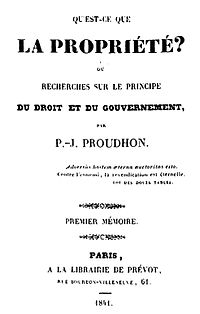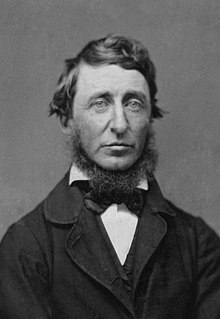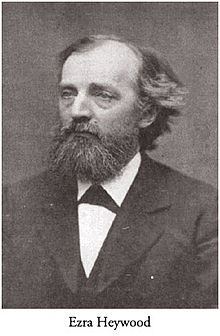Individualist anarchism in the United States
Active Defunct Publications Works Individualist anarchism in the United States was strongly influenced by Benjamin Tucker, Josiah Warren, Ralph Waldo Emerson, Lysander Spooner, Pierre-Joseph Proudhon, Max Stirner, Herbert Spencer and Henry David Thoreau.
[8] For anarchist historian Eunice Minette Schuster, American individualist anarchism "stresses the isolation of the individual – his right to his own tools, his mind, his body, and to the products of his labor.
[12] Mutualism is an anarchist school of thought which can be traced to the writings of Pierre-Joseph Proudhon, who envisioned a society where each person might possess a means of production, either individually or collectively, with trade representing equivalent amounts of labor in the free market.
However, some contemporary mutualists outside the classical anarchist tradition abandoned the labor theory of value and prefer to avoid the term socialist due to its association with state socialism throughout the 20th century.
Bey further states that Andrews was "instrumental in founding several 'intentional communities,' including the 'Brownstone Utopia' on 14th St. in New York, & 'Modern Times' in Brentwood, Long Island.
The latter became as famous as the best-known fourierist communes (Brook Farm in Massachusetts & the North American Phalanx in New Jersey) – in fact, Modern Times became downright notorious (for 'Free Love') & finally foundered under a wave of scandalous publicity.
[39] Free love advocates sometimes traced their roots back to Josiah Warren and to experimental communities, viewed sexual freedom as a clear, direct expression of an individual's self-ownership.
In February 1887, the editors and publishers of Lucifer were arrested after the journal ran afoul of the Comstock Act for the publication of a letter condemning forced sex within marriage, which the author identified as rape.
In particular, the court objected to three letters to the editor, one of which described the plight of a woman who had been raped by her husband, tearing stitches from a recent operation after a difficult childbirth and causing severe hemorrhaging.
Ezra Heywood, who had already been prosecuted under the Comstock Law for a pamphlet attacking marriage, reprinted the letter in solidarity with Harman and was also arrested and sentenced to two years in prison.
Ezra Heywood's philosophy was instrumental in furthering individualist anarchist ideas through his extensive pamphleteering and reprinting of works of Josiah Warren such as the True Civilization (1869) and William Batchelder Greene.
Lazarus was also an intellectual contributor to Fourierism and the Free Love movement of the 1850s, a social reform group that called for, in its extreme form, the abolition of institutionalized marriage.
In the United States, freethought was "a basically anti-Christian, anti-clerical movement, whose purpose was to make the individual politically and spiritually free to decide for himself on religious matters.
[45] By default, American individualists had no difficulty accepting the concepts that "one man employ another" or that "he direct him," in his labor but rather demanded that "all natural opportunities requisite to the production of wealth be accessible to all on equal terms and that monopolies arising from special privileges created by law be abolished.
[49][50][51] A major schism occurred later in the 19th century when Tucker and some others abandoned their traditional support of natural rights—as espoused by Lysander Spooner—and converted to an "egoism" modeled upon Stirner's philosophy.
[52] Some Boston anarchists, including Benjamin Tucker, identified themselves as socialists which in the 19th century was often used in the sense of a commitment to improving conditions of the working class (i.e. "the labor problem").
Contributors included Benjamin Tucker, Lysander Spooner, Auberon Herbert, Dyer Lum, Joshua K. Ingalls, John Henry Mackay, Victor Yarros, Wordsworth Donisthorpe, James L. Walker, J. William Lloyd, Florence Finch Kelly, Voltairine de Cleyre, Steven T. Byington, John Beverley Robinson, Jo Labadie, Lillian Harman, and Henry Appleton.
Without the oppression of the state, Labadie believed, humans would choose to harmonize with "the great natural laws ... without robbing [their] fellows through interest, profit, rent and taxes."
[61] Convinced of the necessity of violence to enact social change he volunteered to fight in the American Civil War, hoping thereby to bring about the end of slavery.
[61] Kevin Carson has praised Lum's fusion of individualist laissez-faire economics with radical labor activism as "creative" and described him as "more significant than any in the Boston group".
[62] Some of the American individualist anarchists later in this era such as Benjamin Tucker abandoned natural rights positions and converted to Max Stirner's egoist anarchism.
Tucker comments that "[s]o bitter was the conflict that a number of natural rights proponents withdrew from the pages of Liberty in protest even though they had hitherto been among its frequent contributors.
[64] Among those American anarchists who adhered to egoism include Benjamin Tucker, John Beverley Robinson, Steven T. Byington, Hutchins Hapgood, James L. Walker, Victor Yarros and E. H.
[66] James L. Walker published the work The Philosophy of Egoism in which he argued that egosim "implies a rethinking of the self-other relationship, nothing less than 'a complete revolution in the relations of mankind' that avoids both the 'archist' principle that legitimates domination and the 'moralist' notion that elevates self-renunciation to a virtue.
[75] Enrico Arrigoni, pseudonym of Frank Brand, was an Italian American individualist anarchist Lathe operator, house painter, bricklayer, dramatist and political activist influenced by the work of Max Stirner.
Indeed, lifestyle anarchism today is finding its principal expression in spray-can graffiti, post-modernist nihilism, antirationalism, neoprimitivism, anti-technologism, neo-Situationist 'cultural terrorism,' mysticism, and a 'practice' of staging Foucauldian 'personal insurrections'".
[81] Hakim Bey has said that "[f]rom Stirner's 'Union of Self-Owning Ones' we proceed to Nietzsche's circle of 'Free Spirits' and thence to Charles Fourier's 'Passional Series', doubling and redoubling ourselves even as the Other multiplies itself in the eros of the group".
Dyer Lum, Ezra & Angela Haywood represent this school of thought; Jo Labadie, who wrote for Tucker's Liberty, made himself a link between the American 'plumb-line' anarchists, the 'philosophical' individualists, & the syndicalist or communist branch of the movement; his influence reached the Mackay Society through his son, Laurance.
[103] Referred to as left-wing market anarchists[104] or market-oriented left-libertarians,[100] proponents of this approach strongly affirm the classical liberal ideas of self-ownership and free markets while maintaining that taken to their logical conclusions, these ideas support anti-capitalist, anti-corporatist, anti-hierarchical, pro-labor positions in economics; anti-imperialism in foreign policy; and thoroughly liberal or radical views regarding such cultural issues as gender, sexuality and race.
[108] Carson–Long-style left-libertarianism is rooted in 19th century mutualism and in the work of figures such as the socialist Thomas Hodgskin and the individualist anarchists Benjamin Tucker and Lysander Spooner.











